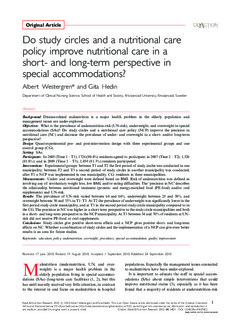| dc.contributor.author | Westergren, Albert | |
| dc.contributor.author | Hedin, Gita | |
| dc.date.accessioned | 2018-03-23T12:09:52Z | |
| dc.date.available | 2018-03-23T12:09:52Z | |
| dc.date.issued | 2010 | |
| dc.identifier.citation | Westergren, A. & Hedin, G. (2010). Do study circles and a nutritional care policy improve nutritional care in a short- and long-term perspective in special accommodations? Food and Nutrition Research, 54. | nb_NO |
| dc.identifier.issn | 1654-661X | |
| dc.identifier.uri | http://hdl.handle.net/11250/2491921 | |
| dc.description.abstract | BACKGROUND: Disease-related malnutrition is a major health problem in the elderly population and management issues are under-explored.
OBJECTIVES: What is the prevalence of undernutrition-risk (UN-risk), underweight, and overweight in special accommodations (SAs)? Do study circles and a nutritional care policy (NCP) improve the precision in nutritional care (NC) and decrease the prevalence of under- and overweight in a short- and/or long-term perspective?
DESIGN: Quasi-experimental pre- and post-intervention design with three experimental groups and one control group (CG).
SETTING: SAs.
PARTICIPANTS: In 2005 (Time 1 - T1), 1726 (90.4%) residents agreed to participate; in 2007 (Time 2 - T2), 1,526 (81.8%); and in 2009 (Time 3 - T3), 1,459 (81.3%) residents participated.
INTERVENTIONS: EXPERIMENTAL GROUPS: between T1 and T2 the first period of study circles was conducted in one municipality; between T2 and T3 a second period of study circles in another municipality was conducted; after T1 a NCP was implemented in one municipality. CG: residents in three municipalities.
MEASUREMENTS: Under- and overweight were defined based on BMI. Risk of undernutrition was defined as involving any of: involuntary weight loss, low BMI, and/or eating difficulties. The 'precision in NC' describes the relationship between nutritional treatment (protein- and energy-enriched food (PE-food) and/or oral supplements) and UN-risk.
RESULTS: The prevalence of UN-risk varied between 64 and 66%, underweight between 25 and 30%, and overweight between 30 and 33% in T1-T3. At T2 the prevalence of underweight was significantly lower in the first period study circle municipality, and at T3 in the second period study circle municipality compared to in the CG. The precision in NC was higher in a short-term perspective in the study circle municipalities and both in a short- and long-term perspective in the NCP municipality. At T3 between 54 and 70% of residents at UN-risk did not receive PE-food or oral supplements.
CONCLUSIONS: Study circles give positive short-term effects and a NCP gives positive short- and long-term effects on NC. Whether a combination of study circles and the implementation of a NCP can give even better results is an area for future studies. | nb_NO |
| dc.rights | Navngivelse-Ikkekommersiell 4.0 Internasjonal | * |
| dc.rights.uri | http://creativecommons.org/licenses/by-nc/4.0/deed.no | * |
| dc.subject | nutrition epidemiology | nb_NO |
| dc.subject | education | nb_NO |
| dc.subject | policy | nb_NO |
| dc.subject | undernutrition | nb_NO |
| dc.subject | overweight | nb_NO |
| dc.subject | special accommodation | nb_NO |
| dc.subject | quality improvement | nb_NO |
| dc.subject | ernæring | nb_NO |
| dc.subject | pasientsikkerhet | nb_NO |
| dc.title | Do study circles and a nutritional care policy improve nutritional care in a short- and long-term perspective in special accommodations? | nb_NO |
| dc.type | Journal article | nb_NO |
| dc.source.volume | 54 | nb_NO |
| dc.source.journal | Food & Nutrition Research (FNR) | nb_NO |
| dc.identifier.doi | 10.3402/fnr.v54i0.5402 | |

